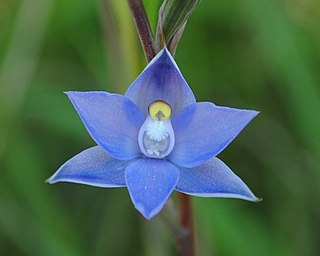
Thelymitra nuda, commonly known as the plain sun orchid is a species of orchid that is endemic to eastern Australia. It has a single fleshy, channelled leaf and up to twelve dark blue to purplish, sometimes white or pinkish flowers with white tufts on top of the anther. It grows in a range of habitats and sometimes forms large colonies.
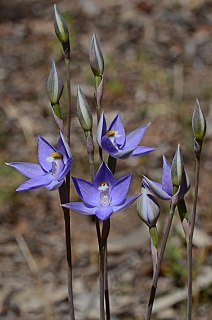
Thelymitra alcockiae, commonly called Kath's sun orchid, is a species of orchid that is endemic to southern continental Australia. It has a single long, narrow leaf and up to twelve pale blue to deep purplish blue flowers, mauve or reddish on their back side.
Thelymitra imbricata, commonly called the broad sun orchid, is a species of orchid that is endemic to Tasmania. It has a single erect, channelled leaf and up to fifteen or more pale to dark or purplish blue, relatively large flowers.
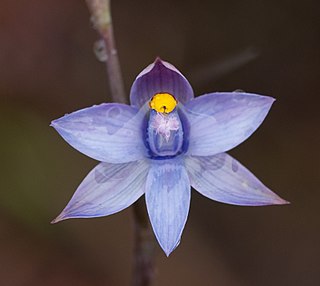
Thelymitra malvina, commonly called the mauve-tufted sun orchid, is a species of orchid that is native to eastern Australia and New Zealand. It has a single large, fleshy leaf and up to twenty five blue to mauve flowers with pink or mauve tufts on top of the anther.
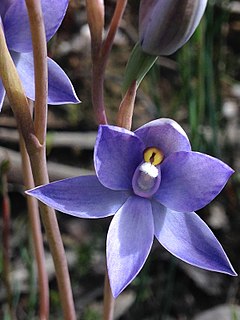
Thelymitra megacalyptra, commonly called the plains sun orchid, is a species of orchid that is endemic to eastern Australia. It has a single erect, fleshy leaf and up to fifteen blue to purplish, sometimes lilac, pink or white flowers with white tufts on top of the anther. It is known as Thelymitra megcalyptra by some authorities.
Thelymitra exigua, commonly called the short sun orchid, is a species of orchid that is endemic to south-eastern Australia. It has a single fleshy, channelled, dark green leaf and up to eight relatively small pale blue flowers with white toothbrush-like tufts on top of the anther.
Thelymitra cyanapicata, commonly called the dark-tipped sun orchid, is a species of orchid that is endemic to South Australia. It has a single fleshy, linear, channelled leaf and up to three small blue or pale purplish to maroon flowers with a dark purplish blue top of the anther.
Thelymitra inflata, commonly called the inflated sun orchid, is a species of orchid that is endemic to south eastern Australia. It has a single long, erect, linear leaf and up to six dark blue to purplish flowers with a very inflated lobe on top of the anther.

Thelymitra mucida, commonly called the plum sun orchid or plum orchid, is a species of orchid that is endemic to southern Australia. It has a single erect, fleshy, linear leaf and up to six blue, purplish or plum coloured flowers with a thick, sticky secretion on the anther lobe.
Thelymitra silena, commonly called the madonna sun orchid, is a species of orchid that is endemic to Tasmania. It has a single thick, fleshy, channelled leaf and up to fifteen pale blue flowers with an almost spherical yellow lobe on top of the anther.
Thelymitra polychroma, commonly called the rainbow sun orchid, is a species of orchid that is endemic to Tasmania. It has a single narrow, fleshy leaf and up to four blue and mauve flowers with darker veins. It grows in windswept heath and swampy areas and the flowers are self-pollinated.
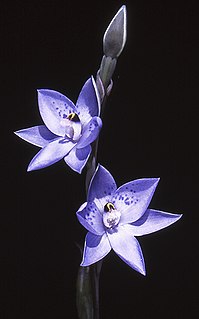
Thelymitra simulata, commonly called the collared sun orchid, is a species of orchid that is endemic to south-eastern Australia. It has a single fleshy, channelled leaf and up to six blue flowers with small darker spots. It grows in higher altitudes places part and the flowers have a purple lobe with a yellow tip on top of the anther.
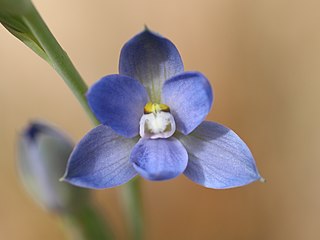
Thelymitra improcera, commonly called the coastal sun orchid, is a species of orchid that is endemic to south-eastern Australia. It has a single erect, fleshy leaf and up to eight relatively small pale to bright blue flowers on a short flowering stem. The lobe on top of the anther is unusually short and lobed.
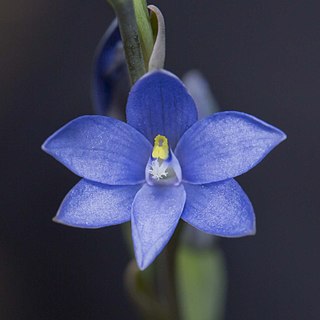
Thelymitra longiloba, commonly called the lobed sun orchid, is a species of orchid that is endemic to south-eastern Australia. It has a single erect, fleshy, channelled leaf and up to six relatively small blue flowers with side lobes above the anther. Although widespread, it only occurs in disjunct populations and is classed as "endangered".
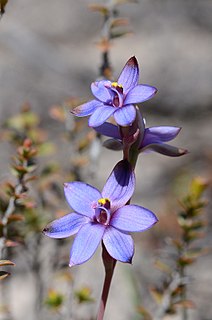
Thelymitra azurea, commonly called the azure sun orchid, is a species of orchid that is endemic to south-eastern Australia. It has a single fleshy, grass-like leaf and up to ten dark azure blue flowers with darker veins. The lobe on top of the anther has a toothed or warty tip.
Thelymitra jonesii, commonly called the skyblue sun orchid, is a species of orchid that is endemic to Tasmania. It has a single erect, fleshy, linear, dark green leaf and up to six relatively small light blue to azure blue flowers with darker veins. It is a rare orchid known from only four scattered locations in moist coastal heath.
Thelymitra latiloba, commonly called the wandoo sun orchid or wandoo shirt orchid, is a species of orchid in the family Orchidaceae and endemic to the south-west of Western Australia. It has a single erect, fleshy, channelled, dark green leaf and up to twelve blue flowers with darker blue veins and sometimes flushed with mauve. The lobe on top of the anther is wavy.
Thelymitra erosa, commonly called the striped sun orchid, is a species of orchid that is endemic to Tasmania. It has a single erect, fleshy dark green leaf and up to eight moderately large dark blue to purplish or pink flowers with darker veins. The column arms have irregular lobes.
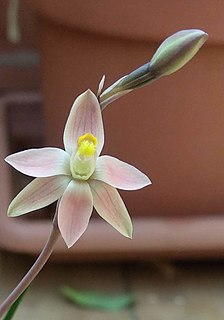
Thelymitra glaucophylla is a species of orchid that is endemic to South Australia. It has a single erect, channelled, pale green leaf and up to fifteen pale blue, mauve or white flowers with an inflated, greyish lobe on top of the anther.
Thelymitra merraniae, known as Thelymitra × merraniae by some Australian authorities, and commonly called Merran's sun orchid, is a species of orchid that is endemic to south-eastern Australia. It has a single tapering, fleshy, channelled, dark green leaf and up to six dark blue to purplish flowers. It is a possibly a natural hybrid but its parentage is uncertain.










